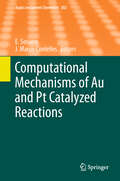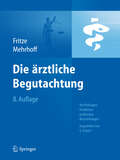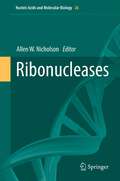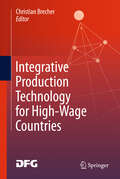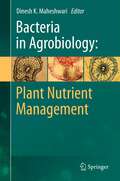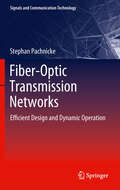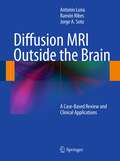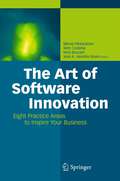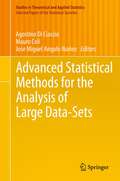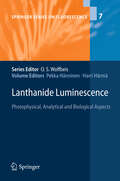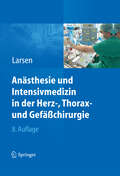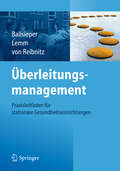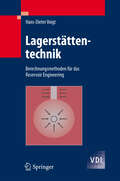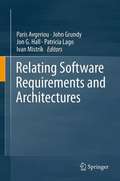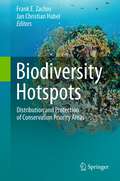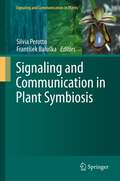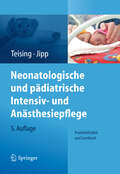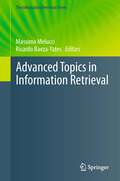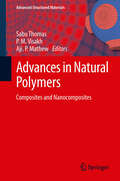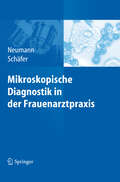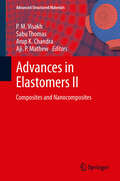- Table View
- List View
Computational Mechanisms of Au and Pt Catalyzed Reactions (Topics in Current Chemistry #302)
by José Marco-Contelles Elena SorianoStructure, Bonding, and Reactivity of Reactant Complexes and Key Intermediates, by Elena Soriano and José Marco-Contelles.- Cycloisomerization of 1,n-Enynes Via Carbophilic Activation, by Patrick Yves Toullec and Véronique Michelet.- DFT-Based Mechanistic Insights into Noble Metal-Catalyzed Rearrangement of Propargylic Derivatives: Chirality Transfer Processes, by Olalla Nieto Faza and Angel R. de Lera.- N-Heterocyclic Carbene Complexes of Au, Pd, and Pt as Effective Catalysts in Organic Synthesis, by Andrea Correa, Steven P. Nolan and Luigi Cavallo.- Activation of Allenes by Gold Complexes: A Theoretical Standpoint, by Max Malacria, Louis Fensterbank and Vincent Gandon.- Heterocyclization of Allenes Catalyzed by Late Transition Metals: Mechanisms and Regioselectivity, by Benito Alcaide, Pedro Almendros, Teresa Martínez del Campo, Elena Soriano and José Marco-Contelles.- Gold-Catalyzed Cycloadditions Involving Allenes: Mechanistic Insights from Theoretical Studies, by Sergi Montserrat, Gregori Ujaque, Fernando López, José L. Mascareñas and Agustí Lledós.-
Die Ärztliche Begutachtung
by E. Fritze Jürgen Fritze Friedrich MehrhoffDie Erstellung eines medizinisches Gutachtens erfordert ein enormes Fachwissen von den einzelnen Fachdisziplinen. Das Standardwerk für ärztliche Gutachter erscheint nun in der 8., komplett aktualisierten Auflage und gilt als unverzichtbares Nachschlagewerk: - Anordnung der medizinischen Kapitel nach Organsystemen - Konsequente Strukturierung nach Epidemiologie, Kernsymptomenm Ätiopathogenese, Therapie option und Prognose - Angaben zur Evidenz und Leistungsfähigkeit von Menschen gemäß der ICF - Umfangreiches Stichwortverzeichnis zum Nachschlagen Es bietet Ärzten als Gutachter, Sachverständige und Berater der sozialrechtlichen Institutionen, Gerichte und Versicherungen gutachtliches Wissen und umfassende Übersicht über die rechtlichen Voraussetzungen und das Fachwissen aller medizinischen Fachgebiete - von der Frage der Berentung wegen Erwerbsminderung und den Berufskrankheiten über die Arzthaftung bis zur Frage der Schuldfähigkeit.
Ribonucleases
by Allen W. NicholsonRibonucleases are a ubiquitous and functionally diverse group of enzymes that have a common ability to cleave RNA. Either through scission of internal phosphodiesters, or removal of nucleotides from RNA 5' or 3' ends, ribonucleases perform essential roles in gene expression and regulation, genome replication and maintenance, host defense, stress response, and viral strategies of infection. Ribonucleases have also served as highly informative models to understand virtually every aspect of biomolecular structure and function. The fifteen chapters in this volume are written by recognized researchers in the field, and provide in-depth analyses of the major ribonuclease families. Particular focus is given to the relation of ribonuclease structure and mechanism to biological function, as well as ribonuclease dysfunction in certain disease states. Other topics include the evolutionary genetics and functional diversification of ribonucleases, engineered ribonucleases as anti-cancer agents, the mechanisms of action of artificial ribonucleases, and ribonucleases as models to understand protein folding and stability. This volume should serve as an essential reference for a broad range of researchers and educators with interests in RNA metabolism, enzymology, and gene regulation.
Integrative Production Technology for High-Wage Countries
by Christian BrecherIndustrial production in high-wage countries like Germany is still at risk. Yet, there are many counter-examples in which producing companies dominate their competitors by not only compensating for their specific disadvantages in terms of factor costs (e.g. wages, energy, duties and taxes) but rather by minimising waste using synchronising integrativity as well as by obtaining superior adaptivity on alternating conditions. In order to respond to the issue of economic sustainability of industrial production in high-wage countries, the leading production engineering and material research scientists of RWTH Aachen University together with renowned companies have established the Cluster of Excellence "Integrative Production Technology for High-Wage Countries". This compendium comprises the cluster's scientific results as well as a selection of business and technology cases, in which these results have been successfully implemented into industrial practice in close cooperation with more than 30 companies of the industrial production sector.
Bacteria in Agrobiology: Plant Nutrient Management
by Dinesh K. MaheshwariThe future of agriculture strongly depends on our ability to enhance productivity without sacrificing long-term production potential. An ecologically and economically sustainable strategy is the application of microorganisms, such as the diverse bacterial species of plant growth promoting bacteria (PGPB). The use of these bio-resources for the enhancement of crop productivity is gaining worldwide importance. "Bacteria in Agrobiology: Plant Nutrient Management" focus on the management of plant nutrient to support plant growth and development. The topics treated in this book include mechanisms of plant growth promoting rhizobacteria, zinc and phosphate solubilizing microorganisms, sulfur oxidizing bacteria, ACC deaminase, siderophores, phytohormones, quorum-sensing, biofilms, antibiotics, volatiles, denitrification and integrated nutrient management.
Fiber-Optic Transmission Networks
by Stephan PachnickeNext generation optical communication systems will have to transport a significantly increased data volume at a reduced cost per transmitted bit. To achieve these ambitious goals optimum design is crucial in combination with dynamic adaptation to actual traffic demands and improved energy efficiency. In the first part of the book the author elaborates on the design of optical transmission systems. Several methods for efficient numerical simulation are presented ranging from meta-model based optimization to parallelization techniques for solving the nonlinear Schrödinger equation. Furthermore, fast analytical and semi-analytical models are described to estimate the various degradation effects occurring on the transmission line. In the second part of the book operational aspects of optical networks are investigated. Physical layer impairment-aware routing and regenerator placement are studied. Finally, it is analyzed how the energy efficiency of a multi-layer optical core network can be increased by dynamic adaptation to traffic patterns changing in the course of the day.
Diffusion MRI Outside the Brain
by Ramón Ribes Antonio Luna Jorge A. SotoRecent advances in MR technology permit the application of diffusion MRI outside of the brain. In this book, the authors present cases drawn from daily clinical practice to illustrate the role of diffusion sequences, along with other morphological and functional MRI information, in the work-up of a variety of frequently encountered oncological and non-oncological diseases. Breast, musculoskeletal, whole-body, and other applications are covered in detail, with careful explanation of the pros and cons of diffusion MRI in each circumstance. Quantification and post-processing are discussed, and advice is provided on how to acquire state of the art images, and avoid artifacts, when using 1.5- and 3-T magnets. Applications likely to emerge in the near future, such as for screening, are also reviewed. The practical approach adopted by the authors, combined with the wealth of high-quality illustrations, ensure that this book will be of great value to practitioners.
The Art of Software Innovation: Eight Practice Areas to Inspire your Business
by Nick Boucart Wim Codenie Minna Pikkarainen José Antonio Heredia AlvaroImagine that you are the CEO of a software company. You know you compete in an environment that does not permit you to treat innovation as a secondary issue. But how should you manage your software innovation to get the most out of it? This book will provide you with the answer. Software innovation is multifaceted and the approaches used by companies can be very different. The team of authors that wrote this book took the assumption that there is no such thing as a universal software engineering process or innovation process. Some things work well for a certain company, others do not. The book is organized around what the authors call eight fundamental practice areas for innovation with software. Each practice area contains a number of activities that can help companies to master that practice area. It also contains industrial experience reports that illustrate the applicability of these practice areas in software companies and is structured in such a way that you can select and read only those practice areas that are relevant to your company. The book is written with an industrial target audience in mind. Its most important goal is to challenge companies by offering them a framework to become more innovation-driven, rather than engineering-driven. Intrigued? Here you will find details of what you and your company can do to understand, implement, and sustain continuous innovation.
Advanced Statistical Methods for the Analysis of Large Data-Sets (Studies in Theoretical and Applied Statistics)
by Jose Miguel Angulo Ibanez Mauro Coli Agostino Di CiaccioThe theme of the meeting was "Statistical Methods for the Analysis of Large Data-Sets". In recent years there has been increasing interest in this subject; in fact a huge quantity of information is often available but standard statistical techniques are usually not well suited to managing this kind of data. The conference serves as an important meeting point for European researchers working on this topic and a number of European statistical societies participated in the organization of the event. The book includes 45 papers from a selection of the 156 papers accepted for presentation and discussed at the conference on "Advanced Statistical Methods for the Analysis of Large Data-sets."
Lanthanide Luminescence
by Pekka Hänninen Harri HärmäLanthanides have fascinated scientists for more than two centuries now, and since efficient separation techniques were established roughly 50 years ago, they have increasingly found their way into industrial exploitation and our everyday lives. Numerous applications are based on their unique luminescent properties, which are highlighted in this volume. It presents established knowledge about the photophysical basics, relevant lanthanide probes or materials, and describes instrumentation-related aspects including chemical and physical sensors. The uses of lanthanides in bioanalysis and medicine are outlined, such as assays for in vitro diagnostics and research. All chapters were compiled by renowned scientists with a broad audience in mind, providing both beginners in the field and advanced researchers with comprehensive information on on the given subject.
Anästhesie und Intensivmedizin in Herz-, Thorax- und Gefäßchirurgie
by Reinhard LarsenDer Band bietet eine Anleitung zum anästhesiologischen und intensivmedizinischen Management in der Herz-, Thorax- und Gefäßchirurgie und bereitet Anästhesisten und Intensivmediziner zugleich auf besondere Situationen vor: Vorbereitung des Patienten, intra- und postoperative Überwachung des Patienten, Umgang mit der Herz-Lungen-Maschine, Reaktion auf Komplikationen. Die Inhalte sind klar strukturiert, das Nachschlagewerk bietet zahlreiche Tabellen und Abbildungen sowie Tipps und Tricks aus der Praxis. Die 8. Auflage wurde durchgehend aktualisiert.
Überleitungsmanagement
by Ulrich Lemm Christine Von Reibnitz Katja BallsieperWer Patienten eine gute Nachversorgung bieten will, ist auf strukturierte Abläufe, gebündelte Informationsweitergabe und eine gute Zusammenarbeit mit in- wie externen Partnern angewiesen. Das Praxisbuch unterstützt Pflegeteams in Krankenhäusern und stationären Pflegeeinrichtungen dabei, alle ärztlichen, pflegerischen und therapeutischen Informationen besser miteinander zu verknüpfen. Tipps, Formulare und Checklisten helfen, Standards für die Informationsweitergabe und die Überleitung zu entwickeln und in die Arbeitsabläufe zu integrieren.
Lagerstättentechnik
by Hans-Dieter VoigtIn dem Band wird die Durchführung von lagerstättentechnischen Felduntersuchungen erläutert und ihre Anwendung anhand vieler Beispiele demonstriert. Ausgehend von Modellvorstellungen werden Interpretationsmethoden für Öl-, Wasser- und Gastests in vertikalen und horizontalen Bohrungen gezeigt. Behandelt werden auch Analysemethoden für hydraulische Fracs, Gestängetests und Verfahren zur Bewertung von Reserven. Der Anhang enthält Korrelationsdiagramme mit den relevanten Eigenschaften von Fluiden (Öl, Wasser, Erdgas und CO2) und von porösen Materialien.
Relating Software Requirements and Architectures
by John Grundy Ivan Mistrík Jon G. Hall Patricia Lago Paris AvgeriouWhy have a book about the relation between requirements and software architecture? Understanding the relation between requirements and architecture is important because the requirements, be they explicit or implicit, represent the function, whereas the architecture determines the form. While changes to a set of requirements may impact on the realization of the architecture, choices made for an architectural solution may impact on requirements, e.g., in terms of revising functional or non-functional requirements that cannot actually be met. Although research in both requirements engineering and software architecture is quite active, it is in their combination that understanding is most needed and actively sought. Presenting the current state of the art is the purpose of this book. The editors have divided the contributions into four parts: Part 1 "Theoretical Underpinnings and Reviews" addresses the issue of requirements change management in architectural design through traceability and reasoning. Part 2 "Tools and Techniques" presents approaches, tools, and techniques for bridging the gap between software requirements and architecture. Part 3 "Industrial Case Studies" then reports industrial experiences, while part 4 on "Emerging Issues" details advanced topics such as synthesizing architecture from requirements or the role of middleware in architecting for non-functional requirements. The final chapter is a conclusions chapter identifying key contributions and outstanding areas for future research and improvement of practice. The book is targeted at academic and industrial researchers in requirements engineering or software architecture. Graduate students specializing in these areas as well as advanced professionals in software development will also benefit from the results and experiences presented in this volume.
Relating Software Requirements and Architectures
by John Grundy Ivan Mistrík Jon G. Hall Patricia Lago Paris AvgeriouWhy have a book about the relation between requirements and software architecture? Understanding the relation between requirements and architecture is important because the requirements, be they explicit or implicit, represent the function, whereas the architecture determines the form. While changes to a set of requirements may impact on the realization of the architecture, choices made for an architectural solution may impact on requirements, e.g., in terms of revising functional or non-functional requirements that cannot actually be met.Although research in both requirements engineering and software architecture is quite active, it is in their combination that understanding is most needed and actively sought. Presenting the current state of the art is the purpose of this book. The editors have divided the contributions into four parts: Part 1 “Theoretical Underpinnings and Reviews” addresses the issue of requirements change management in architectural design through traceability and reasoning. Part 2 “Tools and Techniques” presents approaches, tools, and techniques for bridging the gap between software requirements and architecture. Part 3 “Industrial Case Studies” then reports industrial experiences, while part 4 on “Emerging Issues” details advanced topics such as synthesizing architecture from requirements or the role of middleware in architecting for non-functional requirements. The final chapter is a conclusions chapter identifying key contributions and outstanding areas for future research and improvement of practice.The book is targeted at academic and industrial researchers in requirements engineering or software architecture. Graduate students specializing in these areas as well as advanced professionals in software development will also benefit from the results and experiences presented in this volume.
Biodiversity Hotspots: Distribution and Protection of Conservation Priority Areas
by Jan Christian Habel Frank E. ZachosBiodiversity and its conservation are among the main global topics in science and politics and perhaps the major challenge for the present and coming generations. This book written by international experts from different disciplines comprises general chapters on diversity and its measurement, human impacts on biodiversity hotspots on a global scale, human diversity itself and various geographic regions exhibiting high levels of diversity. The areas covered range from genetics and taxonomy to evolutionary biology, biogeography and the social sciences. In addition to the classic hotspots in the tropics, the book also highlights various other ecosystems harbouring unique species communities including coral reefs and the Southern Ocean. The approach taken considers, but is not limited to, the original hotspot definition sensu stricto and presents a chapter introducing the 35th hotspot, the forests of East Australia. While, due to a bias in data availability, the majority of contributions on particular taxa deal with vertebrates and plants, some also deal with the less-studied invertebrates. This book will be essential reading for anyone involved with biodiversity, particularly researchers and practitioners in the fields of conservation biology, ecology and evolution.
Dynamic Response of Pre-Stressed Spatially Curved Thin-Walled Beams of Open Profile
by Marina Shitikova Yury A. RossikhinThis short book analyses the dynamic stability with respect to small perturbations, as well as the local damage of geometrically nonlinear elastic, spatially curved, open section beams with axial precompression. Transient waves, which are the surfaces of strong discontinuity and wherein the stress and strain fields experience discontinuities, are used as small perturbations; in so doing the discontinuities are considered to be of small magnitude. Such waves are initiated during low-velocity impacts upon thin-walled beams. The theory of discontinuities and the method of ray expansions which allow one to find the desired fields behind the fronts of the transient waves in terms of discontinuities in time-derivatives of the values to be found, are used as the methods of solution for short-time dynamic processes. The example of using the ray expansions for analyzing the impact response of spatially curved thin-walled beams of open profile is demonstrated by solving the problem about the normal impact of an elastic hemispherical-nosed rod upon an elastic arch representing itself a channel-beam curved along an arc of the circumference. The influence of the initial stresses on the dynamic fields has been investigated.
Signaling and Communication in Plant Symbiosis
by František Baluška Silvia PerottoA multiplicity of biotrophic micro-organisms interact with plants in nature, forming symbiotic relationships that range from mutualism to antagonism. Microorganisms that have adopted biotrophy as a lifestyle are able to colonize the plant and often to cross the plant cell boundaries by forming intracellular structures that are the site of nutrient uptake/exchange. To establish themselves within plant tissues, both mutualistic and pathogenic biotrophs need to overcome the plant defense response through an exchange of molecular signals. Our knowledge of the nature of these signals and their function in the interaction has rapidly increased over the last few years. This volume focuses on the genetic, molecular and cellular components involved in the communication between partners of well-known symbioses, but also reports on the advances for less studied systems.
Alternative Energy Sources (Green Energy and Technology)
by Efstathios E MichaelidesAlternative Energy Sources is designed to give the reader, a clear view of the role each form of alternative energy may play in supplying the energy needs of the human society in the near future (20-50 years). The two first chapters on "energy demand and supply" and "environmental effects," set the tone as to why alternative energy is essential for the future. The third chapter gives the laws of energy conversion processes, as well as the limitations of converting one energy form to another. The section on exergy gives a quantitative background on the capability/potential of each energy source to produce power. The fourth, fifth and sixth chapters are expositions of fission and fusion nuclear energy, the power plants that may produce power from these sources and the issues that will frame the public debate on nuclear energy. The following five chapters include descriptions of the most common renewable energy sources (wind, solar, geothermal, biomass, hydroelectric) some of the less common sources (e.g. tidal and wave energy). The emphasis of these chapters will be on the global potential of each source, the engineering/technical systems that are used in harnessing the potential of each source, the technological developments that will contribute to wider utilization of the sources and environmental effects associated with their wider use. The last three chapters are: "energy storage," which will become an important issue if renewable energy sources are used widely. The fourteen chapters in the book have been chosen so that one may fit a semester University course around this book. At the end of every chapter, there are 10-20 problems and 1-3 suggestions of semester projects that may be assigned to students for further research.
Neonatologische und pädiatrische Intensiv- und Anästhesiepflege
by Dagmar Teising Heike JippDiese Buch richtet sich an Pflegende auf Neugeborenen- und Kinderintensivstationen sowie in der Anästhesie und bietet alle relevanten Inhalte der Fachweiterbildung und umfangreiches Wissen für die tägliche Arbeit mit den Patienten. Die Durchführung von allgemeinen und speziellen Pflegemaßnahmen in der neonatologischen und pädiatrischen Intensivpflege erfordert besondere fachliche und psychosoziale Fähigkeiten. Meistern Sie diese Herausforderung und lernen Sie von den erfahrenen Autorinnen alle wesentlichen Aspekte für die Praxis. Übersichtliche Checklisten ermöglichen Ihnen einen schnellen Zugang zu den wichtigen Informationen und erleichtern den Einstieg in diesen anspruchsvollen Aufgabenbereich.
Neonatologische und pädiatrische Intensiv- und Anästhesiepflege: Praxisleitfaden und Lernbuch
by Dagmar Teising Heike JippDie Anästhesie- und Intensivpflege der kleinsten und kleinen Patienten erfordert eine hohe Kompetenz und Verantwortung. In dem Praxisleitfaden vermitteln die Autorinnen das Fachwissen für pädiatrische und neonatologische Intensivstationen sowie für die Anästhesiepflege und erläutern die Pflegetechniken kurz und präzise. Arbeitshilfen wie Fragen für die Wissensüberprüfung, Checklisten und Tipps für die Elternberatung machen das Buch zum Alltagsbegleiter. Die 5. Auflage wurde an alle neuen relevanten Richtlinien angepasst und durch neue Medikamente sowie das Kapitel „Hirntod und Transplantation“ ergänzt.
Advanced Topics in Information Retrieval (The Information Retrieval Series #33)
by Massimo Melucci Ricardo Baeza-YatesInformation retrieval is the science concerned with the effective and efficient retrieval of documents starting from their semantic content. It is employed to fulfill some information need from a large number of digital documents. Given the ever-growing amount of documents available and the heterogeneous data structures used for storage, information retrieval has recently faced and tackled novel applications. In this book, Melucci and Baeza-Yates present a wide-spectrum illustration of recent research results in advanced areas related to information retrieval. Readers will find chapters on e.g. aggregated search, digital advertising, digital libraries, discovery of spam and opinions, information retrieval in context, multimedia resource discovery, quantum mechanics applied to information retrieval, scalability challenges in web search engines, and interactive information retrieval evaluation. All chapters are written by well-known researchers, are completely self-contained and comprehensive, and are complemented by an integrated bibliography and subject index. With this selection, the editors provide the most up-to-date survey of topics usually not addressed in depth in traditional (text)books on information retrieval. The presentation is intended for a wide audience of people interested in information retrieval: undergraduate and graduate students, post-doctoral researchers, lecturers, and industrial researchers.
Advances in Natural Polymers: Composites and Nanocomposites (Advanced Structured Materials #18)
by Sabu Thomas P. M. Visakh Aji. P MathewThe book summarizes in a comprehensive manner many of the recent technical research accomplishments in the area of natural polymers. It discusses the various attempts reporting on solving this problem from the point of view of the chemistry and the structure of natural polymers, highlighting the drawbacks and advantages of each method and proposal. Based on considerations of structure - property relations, it is possible to obtain fibers with improved strength by making use of their nanostructures and/or mesophase properties of natural polymers. The book is a unique book with contributions from the experts of the biomaterial area research. it covers all topics related to natural biomaterials such as natural rubber, cellulose, chitin, starch, hemicellulose, lignin, alginates, soy protein, casein and their bionanocomposites and applications. This book is a useful reference for scientists, academicians, research scholars and biotechnologists.
Mikroskopische Diagnostik in der Frauenarztpraxis
by Axel Schäfer Gerd NeumannDie lichtmikroskopische Untersuchung von Abstrichpräparaten ist ein kostengünstiges und aussagekräftiges Diagnoseverfahren bei Vaginalinfektionen. Viele Erreger sind schnell und sicher zu identifizieren, so dass therapeutische Maßnahmen oder weiterführende Diagnostik folgen können. Der Band bietet Praxiswissen zur Abstrichentnahme, zur Herstellung von Nativpräparaten, zu Färbemethoden und mikroskopischer Technik. Exzellente Farbabbildungen helfen bei der Interpretation der Präparate. Alle relevanten Krankheitsbilder werden von Experten erläutert.
Advances in Elastomers II: Composites and Nanocomposites (Advanced Structured Materials #12)
by Sabu Thomas P. M. Visakh Aji. P. Mathew Arup K. ChandraThis is the second volume of a two-volume work which summarizes in an edited format and in a fairly comprehensive manner many of the recent technical research accomplishments in the area of Elastomers. "Advances in Elastomers" discusses the various attempts reported on solving these problems from the point of view of the chemistry and the structure of elastomers, highlighting the drawbacks and advantages of each method. It summarize the importance of elastomers and their multiphase systems in human life and industry, and covers all the topics related to recent advances in elastomers, their blends, IPNs, composites and nanocomposites. This second volume is deals with composites and nanocomposites of elastomers.
